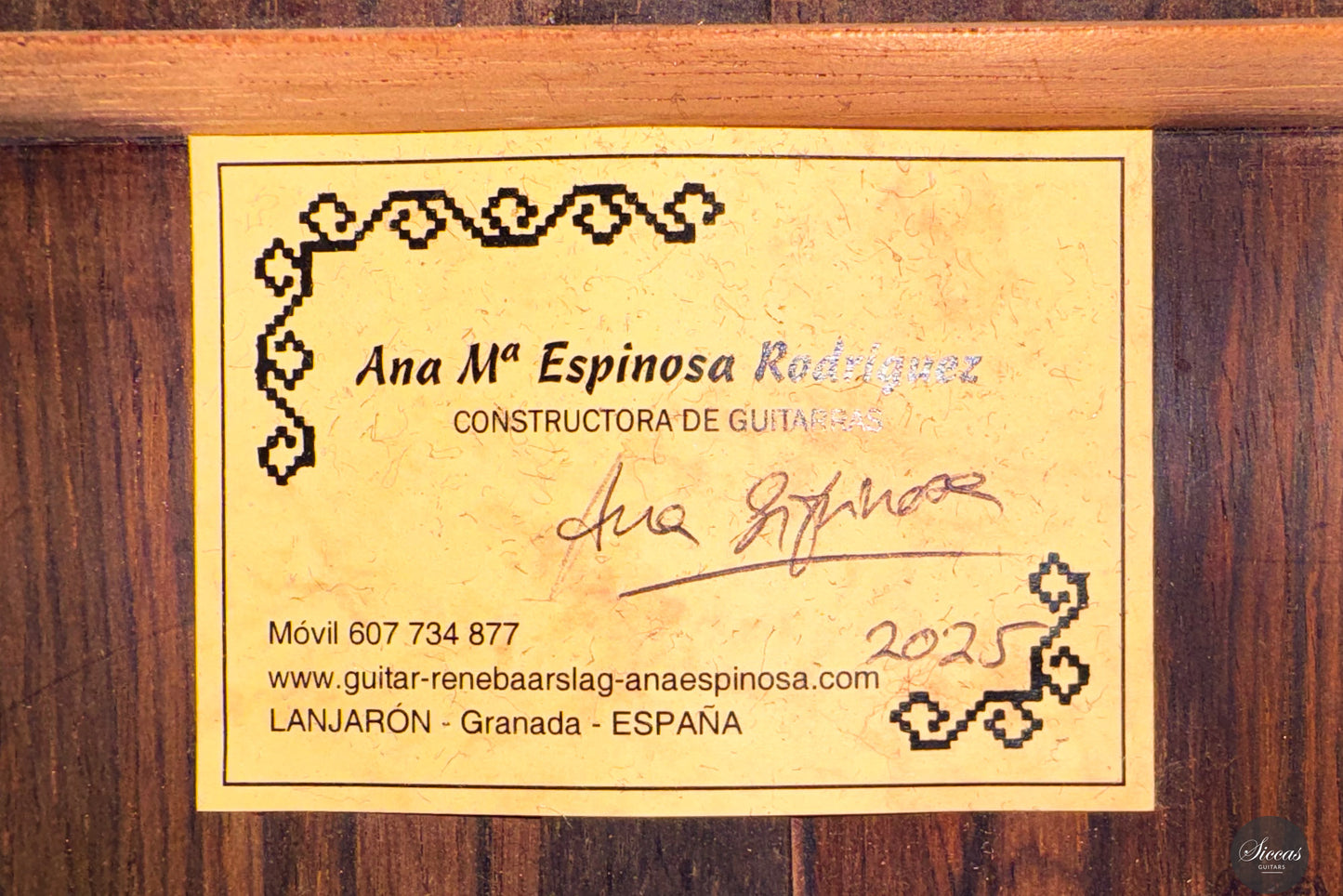Ana Espinosa - 2025 - 64 cm
Ana Espinosa - 2025 - 64 cm
Details
Details
Overview
Overview
Shipping important note
Shipping important note
Delivery times are typically reliable and most instruments arrive within the estimated timeframe.
Should any unexpected delay occur, our team will keep you informed and provide support at every step. For all shipping details and exceptions, please see our Shipping Policy.
Details about GPSR
Details about GPSR






















Video overview


More details about the guitar
About the luthier
Ana Maria Espinosa Rodríguez began her guitarmaking career in 1996 under the mentorship of René Baarslag. Her initial focus on the Antonio de Torres model led her to conduct extensive physical and acoustic analyses, forming the foundation for a personal model that reflects both her research and Baarslag’s deep expertise. Espinosa Rodríguez’s guitars are known for their expressive tonal qualities and graceful aesthetics, consistently featuring high power and strong projection. These attributes contribute to a responsive instrument that supports effortless and nuanced performances. Each guitar is marked by her distinctive headstock and rosette design, built from carefully selected woods and finished to the highest standard.About the guitar
This 2025 Ana Espinosa guitar exemplifies the sonic and visual elegance of the Granada school. It features a cedar top that produces a warm, rounded tone, while the cocobolo back and sides enhance both projection and tonal depth. The instrument offers focused basses and a clear, singing midrange, delivering excellent balance across the register. Built in the traditional Spanish style and finished with French polish, this guitar presents refined craftsmanship suited to the demands of professional performance. The 640 mm scale length makes it particularly appealing for players seeking comfort without compromising on tonal clarity or volume.Regular care extends the life of the instrument
Even with careful use, a classical guitar may gradually change in appearance or respond to unstable storage conditions. Have a close look at your guitar regularly and be attentif to changes. If your instrument is suffering from its environement, it will let you know.
Protect Your Guitar: Handle with Care
Be mindful when touching your instrument with greasy or unwashed hands: any skin contact is a small attack on the varnish. Of course, a guitar is made to be played, but taking a few precautions helps preserve its beauty: wash your hands before playing, wear long sleeves, and avoid unnecessary direct skin contact with the body of the instrument.
Pro tip: Avoid playing with a button-up shirt, heavy jewelry, or a belt, as these can scratch the guitar. Also, make sure your guitar case is free of any objects that could damage the instrument during storage.
String care
A good habit to adopt is wiping down your strings briefly after each playing session. This small action significantly extends their lifespan and helps maintain a consistent, comfortable feel under your fingers.
Most importantly, clean strings are essential for keeping your instrument in tune. Corrosion, sweat, and dust can affect the uniformity of the strings and interfere with accurate tuning across the entire fingerboard.
Pro tip: If you're having trouble getting your guitar in tune, it might be time to change the strings. A useful test is to compare the pitch of the 12th fret harmonic with the fretted note at the 12th fret; if there's an unusually large gap between them, your strings may have lost their integrity and should be replaced.
Keep Your Shellac Finish Shining!
Got a guitar with a shellac (French polish) finish? Here's a simple trick: Take a clean microfiber cloth and gently breathe on the surface to create a light mist. Then, softly rub to remove fingerprints, sweat, and grease. That’s usually all it takes to keep it looking great, no products needed!
Pro tip: Every few years, treat your guitar to a check-up with a luthier to keep it in top shape.
Storing Your Guitar: Climate Matters
Your guitar can safely stay outside its case, as long as the surrounding environment maintains 42–55% humidity and a temperature between 18–25°C.
Keep in mind that humidity levels can still fluctuate inside the case, especially during seasonal changes.
- Too much humidity may cause overtightened strings and a dull tone.
- Too little humidity can lead to a bulging top, string buzz, or even cracks.
Avoid placing your guitar near radiators, air conditioners, or windows with direct sunlight.
Pro tip: Always close your guitar case while playing. This helps preserve a stable microclimate inside the case, so your instrument is protected the moment you put it back in.















































